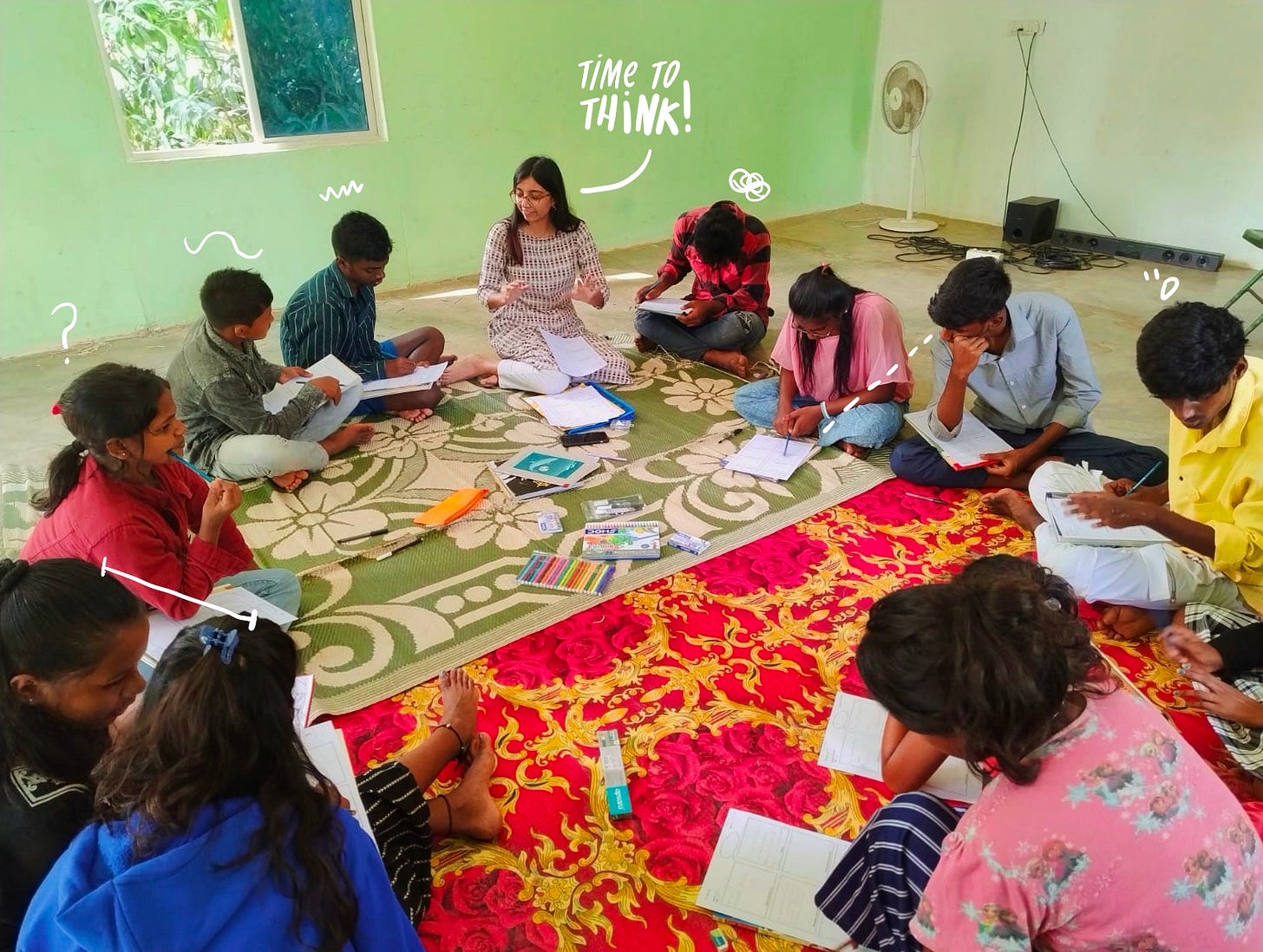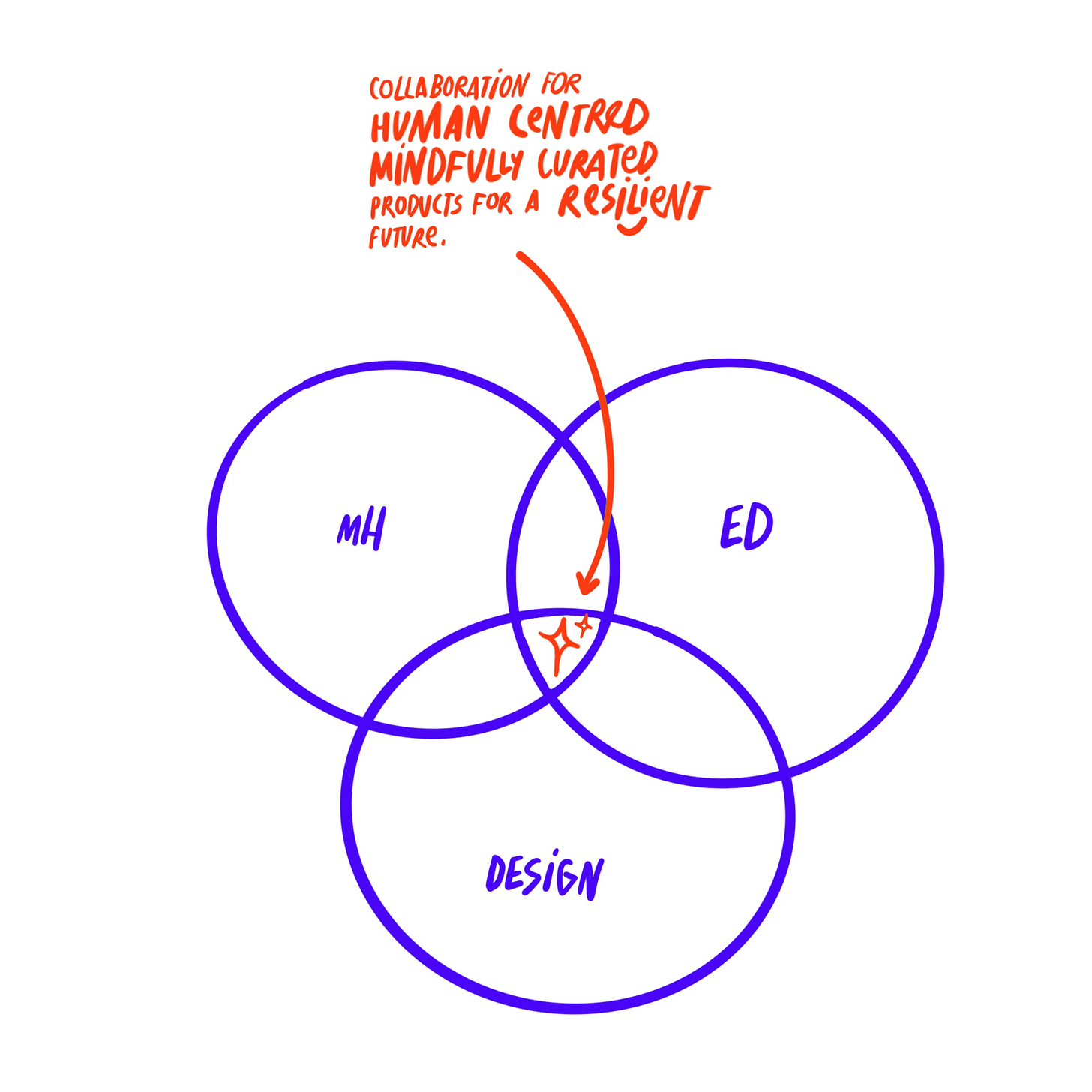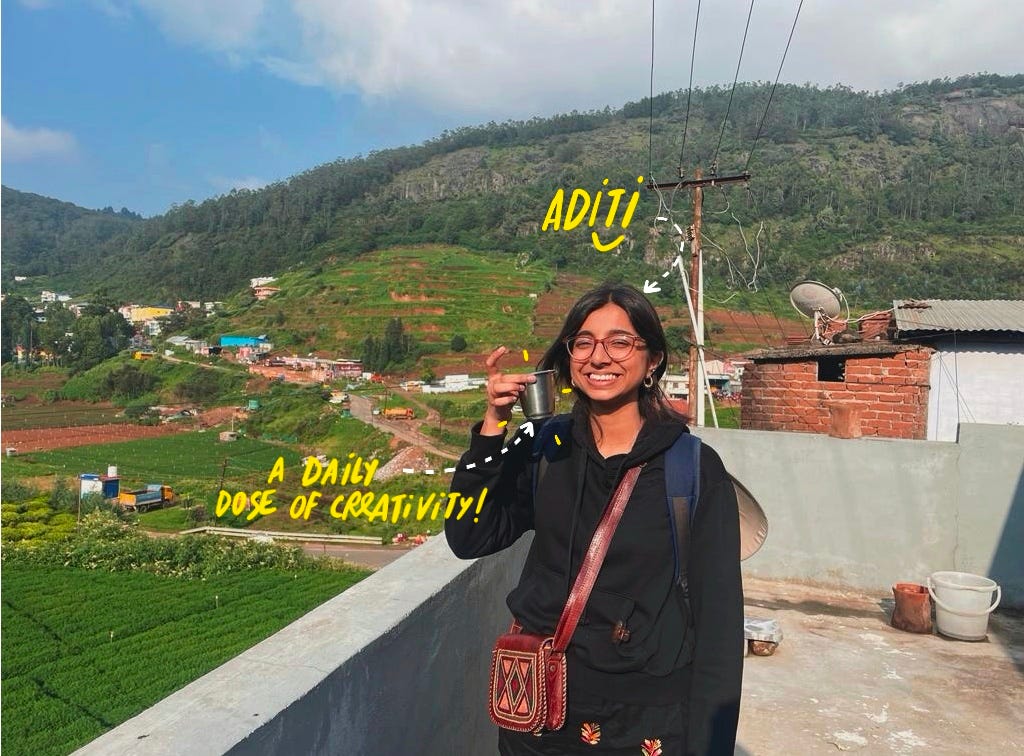Digest #7 — The Slow-Ed Project
Social Emotional Learning for children, but truly for everyone
👋 Hello, I’m Harshali and you’re reading the weekly digest on the mental health tech economy and it’s people.
Despite having a series of future digests lines up, I’ve been struggling with prioritising writing for the last couple of weeks. It doesn’t help that I’m on a career break. However, sitting down to write - crisp cool air, a glass of water, Khruangbin playing softly - continues to bring so much joy that all the procrastination angst is wiped clean. Helps to know that in the last two weeks we’ve had so many more readers join the list. Thank you y’all for the opportunity to keep my drive alive. :)
We have a guest writer today who’ll be sharing a project. You’d know her as the illustrator who’s been running the ‘Weekly Conundrum’ illustration series from all the past digests. Aditi Shinde is a budding product designer paving a path in blending design, psychology, and social development.
Social Emotional Learning
Over the last 22 years, I’ve learned that compassion is not just an innate quality, but something that is shaped by a unique blend of nature and nurture.
Our relationships with caregivers, the socio-political and environmental climate we grow up in, major life events, culture, and even genetic factors all contribute to who we become. These influences affect how we regulate emotions and respond to situations as adults.
At its core, SEL lies at the intersection of psychology and education, with the goal of helping individuals better understand and manage their emotions, set positive goals, empathise with others, establish healthy relationships, and make responsible choices.
While there are several definitions and words for Social Emotional Learning (SEL) — like life skills, 21st century skills, character development—I like to define it as:
SEL is awareness about ourselves and the people around us that helps us have healthy relationships and make good decisions
The Slow-Ed project
I am developing SEL tools for children aged 13 to 16, particularly those from lower-income, migrant families who often miss out on traditional education due to language barriers, lack of financial or mental support, and a disconnect from conventional schooling standards.
This age group experiences a period of significant growth marked by identity development, increased independence, and abstract thinking. School or educational spaces play a crucial role in their lives, providing not just academic knowledge but also emotional support. Yet, emotional literacy is often assumed to be self-taught.
My project aims to break the privilege factor that surrounds mental health and SEL, addressing challenges like gender intentionality, identity, language barriers, and diverse age groups.
My partner NGOs are Gubbachi and Ananya Trust in South Bangalore.
These NGOs have bridge programs for marginalised communities - unique learning spaces for kids who don't fit into mainstream educational institutions. Through them, I experimented with methodologies such as design thinking, speculative and future thinking, journaling, and mindfulness to make SEL inclusive, engaging, and fun.
I believe that if a child truly enjoys being in class, they are more likely to immerse themselves actively and learn. And so, I am now building open source tools that any NGO, school, or institution could use.
Key Inquiries and Goals
The driving questions behind this project focus on making holistic, SEL-based learning a priority and accessible for all, particularly in rural India.
Can we bridge the privilege gap and recognize the need for mental health interventions for every child, regardless of their background?
How might we leverage technology and AI to create more opportunities, encourage experimentation beyond our comfort zones, and integrate SEL into traditional learning environments?
Challenges and Learnings
The feedback from these workshops has been positive, particularly from the children, who have enjoyed having an external facilitator once a week!
However, while curating materials for teachers to use independently, I learned that teachers, often overwhelmed with academic responsibilities, face a steep learning curve. This insight shifted my focus toward a service-oriented approach-
To build products and model them around academics to make Slow-Ed seamless.
Given that the focus group includes a vulnerable set of individuals, one of my main challenges is curating content that empowers them without making them feel inadequate or inferior to others in society.
Design and Social Emotional Learning
As designers, we create experiences and products that focused on needs, preferences and feelings of a user to make things easy, comfortable and enjoyable. Our goal is to make life seamless. We collaborate with expert professionals from various fields to make solutions well rounded.
Similarly, my work in SEL has involved collaborating with psychology experts to create solutions that kids truly enjoy and want to be invested in want to be invested in - like having discussions, developing games, experimenting with theatre, physical exercise or even maker spaces!
SEL encourages a blend of professionals to work together.
The way I view it, psychologists back the solution with the science of behaviour, emotions, and learning, while designers translate the solution from a simple ideas into accessible, engaging, and memorable products, services, and content.
Design thinking is particularly valuable in addressing the gaps in mental health education because it encourages empathy-driven, user-centric solutions. By starting with a deep understanding of the experiences and needs of children, caregivers, and educators, design thinking enables us to identify the root causes of mental health challenges early on.
Design thinking promotes brainstorming, experimentation, and iterative prototyping, allowing for the development of innovative, practical tools and methods that can be integrated into everyday learning environments. This approach fosters a collaborative mindset among all stakeholders—educators, parents, and mental health professionals—ensuring that solutions are not only creative but also feasible and sustainable
Would you like to collaborate?
There’s a lot of opportunity for paid and voluntary work in developing SEL curriculums. I can’t personally hire anyone, but I’d be happy to collaborate with you, or connect you to the right people. Write to me if you are:
MHPs interested in SEL: professionals interested in the psych and education overlap. This could include having a professional interest in art, design, and education, or being a clinical advisory on the tools we develop.
Volunteers for a Picture Book: I am creating a picture book that explores the science behind emotions, behaviours, and the brain, and I am looking for partners interested in this endeavour.
You can find me at aditiswork0@gmail.com and @ditiiee on instagram
About me
I'm Aditi Shinde, a sketch-noter and a Product Design student at the National Institute of Design, Ahmedabad, India. For the past four months I’ve been immersed in my graduation project on SEL and sponsored by the Ford Foundation Grant.
I’ve always been drawn to decipher how to better equip ourselves emotionally from a young age. This project has evolved into a participatory endeavour involving workshops for research, building, and testing.
If you enjoyed this read, consider subscribing or sharing it with a friend who’s interested in Design, SEL or both!
Connect with me, Harshali, on LinkedIn, I’m always looking to meet people working in mhTech. 💌
Until next time,
Harshali







